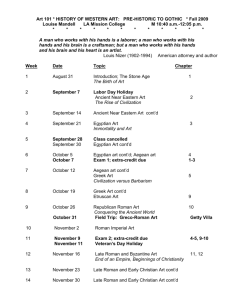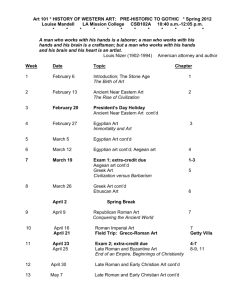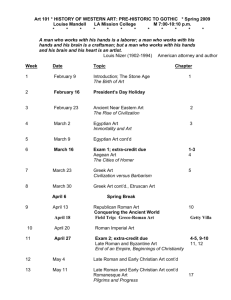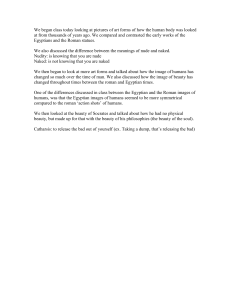Religions of Empire
advertisement
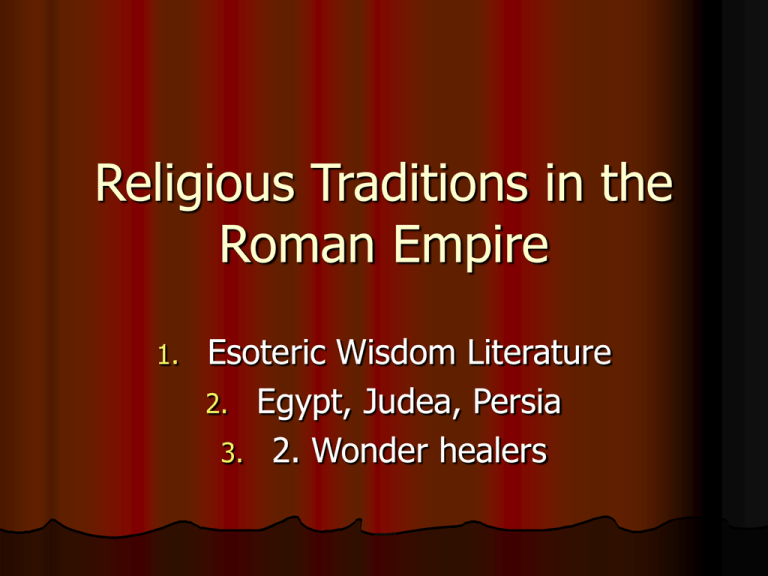
Religious Traditions in the Roman Empire 1. Esoteric Wisdom Literature 2. Egypt, Judea, Persia 3. 2. Wonder healers Religious options in the Roman Empire Wide variety; embracing two broad categories: 1. esoteric wisdom (can be understood by only a few initiates; was exotic and mysterious; included magic 2. cults with claims to special connection with divine. Esoteric wisdom literature Pseudoepigrapha (writings with false attribution) = form of literature published under a particular name (i.e. Pythagoras, 6th century BC philosopher) but written by other authors widespread phenomenon in Graeco-Roman antiquity Played important role in spreading ‘oriental’ wisdom The Egyptian tradition Very attractive - hieroglyphs were mysterious in themselves; enormous antiquity Exotic representation of gods (animal heads) Temple ceremonies hidden from ordinary eyes A secretive priestly caste trained in millennia-old traditions kept secret from ordinary people Egyptian priests capitalized on Graeco-Roman fascination with all things Egyptian – worked as free-lance wise men and wonder workers Became stock characters in literature: Zatchlas in Apuleius calls back the soul of a dead man (2.28) Zatchlas - an Egyptian prophet “ We have here in Zatchlas of Egypt a prophet of the first rank. He has already agreed with me a large fee to bring back the soul of the deceased from the Underworld for a short while and restore his body to life.” So saying he led forward a young man dressed in a linen tunic and palm-leaf sandals with his head shaved bare. Repeatedly he kissed the man’s hands and touched his knees in supplication. ‘Have pity, O Priest,’ he said, ‘ have piety by the stars of heaven, by the infernal powers, by the natural elements, …. (Apuleius, The Golden Ass 2.28) Out of Egypt Cult of Isis widely popular in part because of its Egyptian elements Temples with ostentatious Egyptian décor, priests of cult shaved heads, wore linen robes of traditional Egyptian priests Large collection of texts in Greek claiming to transmit ancient Egyptian wisdom pseudepigrapha were associated with Hermes Trismegistos (Thrice-Greatest-Hermes) = Greek name for Egyptian god Thoth Most famous of these ‘Hermetic’ texts deal with nature of cosmos and role of humanity (later popular with philosophers of the Italian Rennaissance) Hermetic texts deal with wide variety of topics: spells, rituals, astrology, alchemy, medicine, Temple of Isis in Philae (Egypt) Temple of Isis in Pompeii Judaean Tradition Similar appeal as Egyptian tradition: exotic customs, enormous antiquity, sacred scriptures written in strange, mysterious language had distinctive philosophical appeal (like early Greek philosophy) criticizing Greek tradition about gods, especially anthropomorphism and gods’ immoral actions. Had developed concept of divine as beyond human understanding: divine was perfect and good, remote, yet deeply concerned with human morality Note: Judaean tradition conformed to the philosophical conception of the divine as developed by the Greek philosophers Judaean tradition Centrality of scripture in Judaean tradition – well suited to the creation of pseudepigrapha Popular genres in the Roman period: revelations received by a notable figure of Israelite past apocalypse (from Greek: apokalypsis = uncovering), concerned with secrets of heavenly realm, divine judgment, end of world Early example = Book of Daniel; later works written under names of Enoch, Abraham, Baruch, Ezra. Primary audience members of Judaean tradition Other pseudegrapha represent more widespread esoteric traditions: astrological treatise under name of Shem (one of the sons of Noah); spells and ritual lore often ascribed to Moses or Solomon Example: The Eighth Book of Moses provide directions for complex ritual intended to cause the supreme god of the cosmos to appear before the person who performs it PGM IV.850-929, Charm of Solomon that produces a trance (works both on boys and on adults): I swear to you by the holy gods and the heavenly gods not to share the procedure of Solomon with anyone and certainly not to use it for something questionable unless a matter of necessity forces you, lest perchance wrath be preserved for you. Formula to be spoken:[ formula ] …Hear me, that is, my holy voice, because I call upon your holy names, and reveal to me concerning the things which I want, through the NN man or little boy, for otherwise I will not defend your holy and undefiled name…Come to me through the NN man or little boy and tell me accurately since I speak your names which thrice-greatest Hermes wrote in Heliopolis with hieroglyphic letters ….formula… Persian Tradition Persian sage Zoroaster the most prominent – wide range of texts, including astrology Ostanes, asociated with treatises on alchemy and occult, the uses of plants and gems Hystspes, the supposed author of an apocalypse Astrampsychos, credited with popular do-ityourself book of oracles Cult of Mithras, ancient Iranian deity Mithra, worship survived in Asia Minor into Roman period; became popular mystery cult especially with Roman soldiers Cult of Mithras Unusual cult: no public elements, no temples, all cult activities restricted to male initiates Small group of all male initiates met in underground chambers for communal meal and cult ceremonies; very popular among Roman soldiers Initiates passed through a hierarchy of seven grades: one was called ‘Persian’ Chief decoration of meeting place was depiction of Mithras killing a bull and dressed in stereotyped “Persian” clothing: long trousers, full tunic with long sleeves, and so-called “Phrygian” cap. No textual sources for relief. Mithras Divinely inspired religious leaders Every person could pray and make offerings and even interact with gods through oracles, dreams, visions Some people claimed a special connection with the divine which gave them special insights and abilities; were considered superior to ordinary mortals by their followers; credited with abilities to perform miracles and inspired teachings Source difficulties: accounts grew more elaborate over time; surviving accounts are either completely positive or completely negative; Many were highly controversial figures; Roman elite perceived them as threat to their religious authority. Jesus of Nazareth By far the most famous and most controversial of religious leaders Our knowledge comes almost entirely from accounts of his sayings and deeds (gospels) that circulated among his followers. Most scholars agree, earliest accounts were composed 40 years after his death; impossible to determine which elements go back to historical Jesus, and what are later ideas of his followers. Christian sources depict Jesus as wonder-worker, healing the sick, casting out demons, even raising the dead; As moral teacher who emphasized compassion for poor and outcast; As prophet of a coming ‘Kingdom of God”, and as himself as divine. Sources for historical Jesus: Paul of Tarsus ( 5-67 CE) Few non-Christian sources survived; Jesus wrote nothing; Evidence that he raised strong opposition: Tacitus, Annals 15.44.3: “in the reign of Tiberius he was executed by the procurator Pontius Pilatus”. Paul of Tarsus (town in Cilicia) originally opponent of Jesus followers; had r religious experience which he interpreted as revelation of Jesus Christ, presented himself as Christ’s divinely appointed representative to nonJudaeans (Paul, Letter to Galatians 1.11-17) One of few we have first-hand evidence of; wrote letters to followers in Asia Minor, Macedonia, Greece, and Rome (although some Pauline letters are clearly pseudepigrapha). Central message of Paul’s letters: faith in Christ would free people from control of certain negative forces, usually identified as sin, but sometimes associated with external superhuman powers. Author of Acts of Apostles depicts Paul as a wonder-worker, striking a rival with blindness (13.6-12), driving out demons (16.16-18) Executed by Roman authorities in early 67 CE Apollonius of Tyana Wandering Pythagorean philosopher in 1st century CE Have account of his life by Philostratus, early 3rd century CE: depicted as ascetic who rejected animal sacrifice and eating of meat; as moral teacher and religious reformer, as wonder-worker who could prophesy future, drive away evil spirits, raise the dead. Was arrested and tried before the Emperor Domitian, and is said to have simply ‘vanished’ from the courtroom and reappeared to his followers in another city. Note how new myths developed. His followers regarded him as theios = god-like Opponents call him magos and a quack Common characteristics of Divinely inspired religious leaders Figures present differences but also similarities had religious authority but did not hold official priesthoods believed to have privileged access to divine power and knowledge Overlap between claims to special connections to divine and esoteric traditions (mysterious/known by few initiates/magic) example: Apollonius was a follower of Phythagoras and was said to have visited ‘oriental sages’; Jesus and Paul were exponents of Judaean traditions; All had distinct appeal and provided distinctive religious options What did they have to offer? We have very little evidence to determine Roman’s spiritual needs, but evidence tells us what religious options, the various cults, had to offer 1. alternative and more effective ways of addressing concerns (including health) than traditional religion 2. intensification of traditional religious experience; a more profound encounter with divine, or unusually intimate relationship with deity that provided special blessings in life and after death 3. new models of the cosmos and new understanding of human role within it; provided new types of salvation previously unknown. Often they offered all three categories Alternative and more effective traditional benefits Tacitus, Annals 12.22 “Agrippina hated Lollia Paulina who was a rival for the emperor’s hand, and Agrippina was a relentless enemy. In this same year she found an accuser to prosecute Lollia. The charges were association with Chaldaean astrologers and magicians, and the consultation of Apollo’s statue at Clarus concerning Claudius’ marriage. The emperor did not give the defendant a hearing. He himself spoke at length about her noble connections, ..her mother, sister of Lucius Volusius Saturninus, ……but he added that her projects were a national danger and that her potentialities for mischief must be eliminated . She must….have her property confiscated and leave Italy.” Note: both traditional and alternative methods were applied in this case : Chaldaeans, magi, and highly respectable Greek oracle of Apollo all were forms of divination. concerns for health major reason for turning to the gods Equally prominent in alternative religious options Greek Magical Papyri (a book of spells compiled 3rd century CE) include prescriptions for treating a wide range of illnesses, including scorpion stings, headache, cough, swollen testicles, fever , etc. A prayer for the ‘wandering womb’ “I conjure you, O Womb, by the one established over the Abyss, before heaven, earth, sea, light, or darkness came to be; who created the angels, being foremost, amichamchou and chouchao cheroei oueiacho odou proseiogges, and who sit above the cherubim …that you return again to your seat…Hallelujah! Amen!’ Write this on a tin tablet and clothe it in seven colours.’” (PGM VII.260-71) Powers of Healing Power of healing often attributed to those with special connections to the divine: Gospel of Mark recounts how Jesus healed a leper (1.40), a paralytic (2.1-12), man with a withered arm (3.1-5), woman with hemorrhages (5.25-34), etc., similar feats by Peter’ Apollonius of Tyana said to have healed a lame man, a blind man, and a paralytic (Philostratus, Life of Apollonius of Tyana 3.39); also foretold a plague at Ephesus and could later identify the demonic source (many people believed malevolent spirits as cause for illness, especially mental illness Advice and insight into future Another major reason to turn to both traditional and alternative religions Greek Magical Papyri spells include instruction for – direct visions, dream oracles, lamp divination, saucer divination, or (Solomon example earlier) a boy or man is put into trance to act as mouthpiece of god to give advice and foretell the future) Other (not so friendly) reasons for turning to alternative religions Unacceptable aims included to constrain or harm opponents/rivals, or inspire sexual passion in someone Binding spells, both present in magical papyri and in curse tablets (small lead sheets inscribed with ritual formulae and placed underground, sometimes in a grave. Example, binding spells on favoured sports team Spell on a chariot team “ you holy angels, ambush and restrain them, now attack, bind, overturn, cut up chop into pieces the horses and the charioteers of the Blue colors (trans. Gager 1992: no. 5) Sexual desire Many examples in magical papyri and curse tablets of spells were intended to attract a desired person. A curse tablet recording a prayer of a woman who tried to win back a man who broke up with her: “I invoke you, spirit (daimonion) who lies here, by the holy name the god of Abraham and the god of Jacob, god of Israma, hear the honored, dreadful, and great name, go away to Urbanus, to whom Urbana gave birth and bring him to Domitiana, to whom Candida gave birth, so that loving, frantic, and sleepless with love and desire for her, he may beg her to return to his house and become his wife” (trans. Gager 1992: no. 36)
